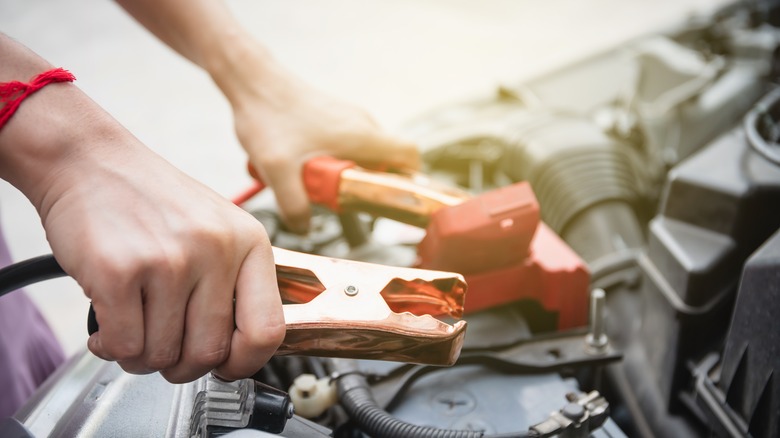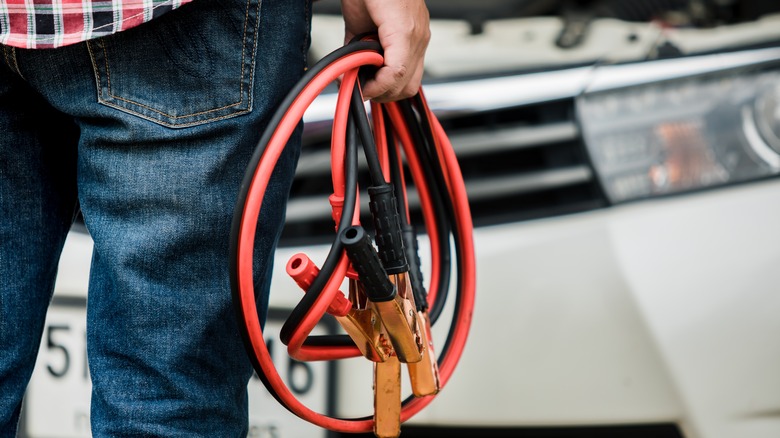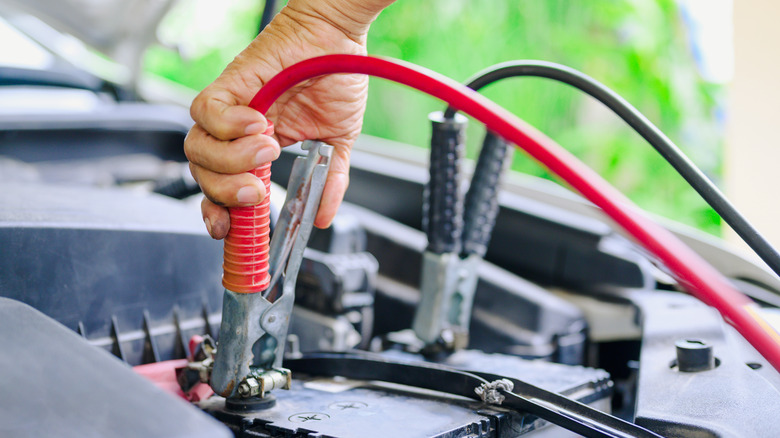How To Properly Jump A Car Battery
A car battery is a crucial component in the proper function of any vehicle, but despite their importance, they can be fickle. ThoughtCo. notes that batteries in virtually all devices perform worse in cold weather, suggesting that car owners in northern regions should always carry jumper cables in the trunk to battle the affects of winter chill. Simply put, this happens as a result of the atomic-level movement of electrons while a battery is in operation. The colder the battery, the slower the electrons will move through the chemical processes, leading the battery to perform with a far weaker charge than it may actually carry.
Lifewire also reports that parasitic drains are a key issue to maintain a vigilant eye against in protecting the integrity and lifespan of your battery. Even in warmer climates and seasons, a battery can succumb to total drainage by a glove compartment light that never shuts off or headlights accidentally left on throughout the weekend.
The takeaway, of course, is that jumping a car battery is a key skill for any driver to master, regardless of local conditions. With these simple steps, the process is made effortless.
How to jump start a car
Getting into your car and turning the key, only to hear the sputtering sounds of a vehicle hauling a dead battery has to be one of the most aggravating experiences in the modern world. Fortunately, with a set of jumper cables and a friendly neighbor or fellow driver, getting your car back on the road is simple:
- Park both cars within reach of one another; you can't jump a car if the leads won't physically connect!
- Clear the work area of any hanging cloth or other items that might pose a hazard or get in the way.
- With both cars parked and switched off, attach one red lead to the working car's positive battery terminal.
- Connect the other red lead to the dead battery's positive terminal.
- Connect the black lead to the working car's negative terminal.
- Attach the other black lead to any part of the unpainted metal chassis of the dead car — don't connect it to the dead battery's negative terminal.
- Start the working vehicle and let the engine (and battery) run for a few minutes.
- Start up the car with the dead battery and leave both to run (connected) for a further couple of minutes before disconnecting the leads in reverse order.
Other things to know about jumping a dead car battery
It's important to note that some car batteries are located in the trunk rather than under the hood (via Click Mechanic), so parking each car accordingly will speed the jump along. Also, the black lead attached to the dead car acts as a grounding point to keep the process as safe as possible. Some cars have a designated grounding point, but cars often sport an unpainted ridge that runs along the entire edge beneath the hood to offer an easy contact.
Following this process should kick the battery back to life once again with little trouble. Mach 1 Service notes that car batteries are recharged through a vehicle's alternator, so running the car once it's back on can reanimate the battery and maintain viability for a bit longer.
Once the car is back on, there is a key decision to make, though. If this is the first time your battery has died, you might want to turn off both cars and restart your vehicle under its own power to test the unit; however, if battery issues are recurring, it may be better to bring the car directly to your mechanic to have the battery replaced or serviced without turning the car off first.


